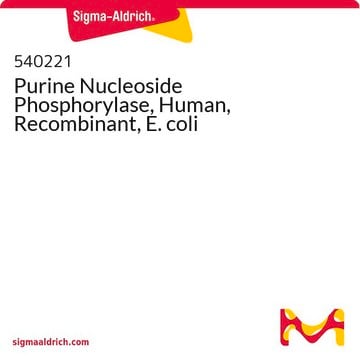T2807
Thymidine Phosphorylase, recombinant from Escherichia coli
recombinant, expressed in E. coli, buffered aqueous solution, ≥500 units/mL
Synonym(s):
Thymidine:orthophosphate deoxy-D-ribosyltransferase
Sign Into View Organizational & Contract Pricing
All Photos(1)
About This Item
CAS Number:
MDL number:
UNSPSC Code:
12352204
NACRES:
NA.54
Recommended Products
recombinant
expressed in E. coli
Quality Level
form
buffered aqueous solution
concentration
≥500 units/mL
UniProt accession no.
storage temp.
2-8°C
Gene Information
Escherichia coli K12 ... deoA(948901)
Looking for similar products? Visit Product Comparison Guide
General description
Thymidine phosphorylase inhibits vascular smooth muscle cell proliferation.
Application
Thymidine phosphorylase has been used in a study to assess TAS-102 treatment in patients with advanced solid tumors. Thymidine phosphorylase has also been used in a study to investigate antitumor effects of the FP3 protein on patient-derived tumor tissue xenograft models of primary colon carcinoma.
Biochem/physiol Actions
An enzyme that catalyzes the reversible conversion of thymidine to thymine. Thymidine phosphorylase is part of the pyrimidine nucleoside salvage pathway. This pathway allows pyrimidine bases to be recycled for nucleotide biosynthesis, while the pentose 1-phosphates are converted to intermediates of the pentose phosphate shunt and glycolysis. The E. coli thymidine phosphorylase shares 40% sequence homology with the human sequence, which has been found to be identical to the angiogenic agent platelet-derived endothelial growth factor. The purified E. coli enzyme has been shown to stimulate blood vessel growth in chick chorioallantoic membrane assays.
Unit Definition
One unit will convert 1.0 μmole each of thymidine and phosphate to thymine and 2-deoxyribose 1-phosphate per min at pH 7.4 at 25°C.
Physical form
Solution in 0.5 M potassium phosphate containing 2 mM uracil, 0.02% sodium azide and bovine serum albumin
Preparation Note
Cloned from E. coli and produced in overexpressing E. coli
Storage Class Code
12 - Non Combustible Liquids
WGK
WGK 2
Flash Point(F)
Not applicable
Flash Point(C)
Not applicable
Personal Protective Equipment
dust mask type N95 (US), Eyeshields, Gloves
Certificates of Analysis (COA)
Search for Certificates of Analysis (COA) by entering the products Lot/Batch Number. Lot and Batch Numbers can be found on a product’s label following the words ‘Lot’ or ‘Batch’.
Already Own This Product?
Find documentation for the products that you have recently purchased in the Document Library.
Customers Also Viewed
Hong-Yun Zhao et al.
Anti-cancer drugs, 23(5), 534-542 (2012-04-07)
The aim of the present study was to investigate the gene expression of biomarkers associated with the sensitivity to fluoropyrimidine and taxanes in recurrent/advanced breast cancer patients treated with first-line capecitabine chemotherapy. We evaluated the clinicopathological/prognostic significance of thymidylate synthase
Michelle Levene et al.
Toxicological sciences : an official journal of the Society of Toxicology, 131(1), 311-324 (2012-09-15)
Erythrocyte-encapsulated thymidine phosphorylase (EE-TP) is currently under development as an enzyme replacement therapy for mitochondrial neurogastrointestinal encephalomyopathy (MNGIE), an autosomal recessive disorder caused by a deficiency of thymidine phosphorylase. The rationale for the development of EE-TP is based on the
Alexandra Giatromanolaki et al.
Cancer biology & therapy, 13(13), 1284-1289 (2012-08-17)
Tumor-associated stroma (TAS) is not simply a supporting element for cancer cells, but plays an important role in tumor growth, invasion and metastasis. Changes on the level of stromal constituents, such as loss of Caveolin-1 and increased thymidine phosphorylase (TP)
Ketao Jin et al.
Cancer biology & therapy, 13(9), 737-744 (2012-05-24)
FP3 is an engineered protein which contains the extracellular domain 2 of VEGF receptor 1 (Flt-1) and extracellular domain 3 and 4 of VEGF receptor 2 (Flk-1, KDR) fused to the Fc portion of human immunoglobulin G 1. Previous studies
Tetsuhiro Goto et al.
Anticancer research, 32(5), 1757-1762 (2012-05-18)
Predictors of the response of colorectal cancer to chemotherapy remain poorly understood. We analyzed the mRNA expression levels of enzymes related to sensitivity to 5-fluorouracil derivatives in patients with colorectal cancer. Danenberg tumor profile method (DTP) was used in order
Our team of scientists has experience in all areas of research including Life Science, Material Science, Chemical Synthesis, Chromatography, Analytical and many others.
Contact Technical Service











